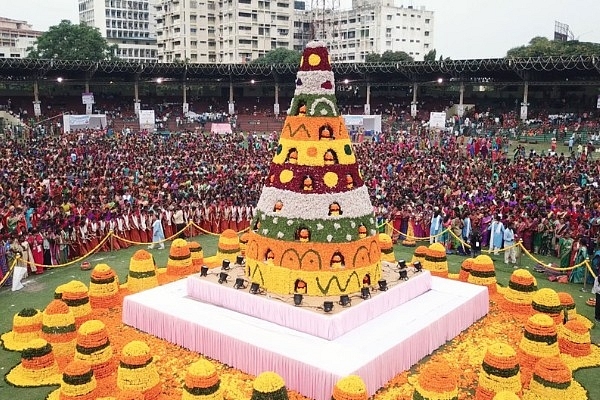
Bathukamma: When Telangana Transforms Into A Valley Of Flowers
The state festival of Telangana, Bathukamma coincides with Navratri celebrations.
It involves nine days of celebration during which time women build shrines made from flowers and turmeric dedicated to the goddess of life, Bathukamma.
As the autumn crop standing in the fields is harvested, cultures across the Indian subcontinent brace themselves to offer their gratitude to the gods and celebrate the gift of life. The rite is ancient and varies across different parts of South Asia. From the Durga puja of Bengal, to the Ram Lilas of the northern plains, the Dussehras of Mysuru and Kullu, and the Dandiya of Gujarat—it is a rich and varied spectrum, recorded, photographed, shared, and celebrated widely in popular culture.
For the most part, it is known as Navratri for the nine nights of prayer and celebration offered to the mother goddess who has offered her bounty to men. Each culture has built around this ancient ritual, a complex and richly layered body of oral and folk traditions. One of the lesser-known faces of these nine nights of celebration is Bathukamma, the state festival of Telangana.
Bathukamma is derived from two Telugu words—Bathuku (life) and Amma (mother). Bathukamma, thus, is the life-giving mother goddess who is welcomed when the autumn harvest is ready, thanks to the bountiful rains. Telangana remains, to this day, largely an agrarian society, removed from the coast, and falling on the leeward side of the Eastern Ghats, thus ensuring that rains and crops have remained vital to sustaining life in this region, where life can often be very harsh.
In the Telangana hinterland, summer temperatures regularly soar above 45 Celsius. Places such as Adilabad and Nizamabad are known to record some of the highest temperatures in South Asia, sometimes even surpassing those in the Thar desert. The rocky land of the Deccan plateau further makes groundwater a precious commodity. It was the Kakatiya rulers of the twelfth century who first built tanks and lakes on a large scale, allowing otherwise arid land to be irrigated.
Water and fertility have, thus, become the central themes of the Bathukamma festival. And what better way to celebrate fertility than through flowers? As the monsoons end, a variety of wildflowers bloom in the local forests of Telangana and Andhra, and through the centuries, these flowers became central to the celebration of this floral festival.
Origins
There are several legends around the origin of Bathukamma. The most popular one revolves around a Chola king, Dharamngada, and his wife Satyawati, who lost a 100 sons in battle and prayed to goddess Lakshmi for a daughter. The goddess not only granted their wish but herself appeared as the daughter of the royal couple. The sages Kapila, Kasyapa, Vashishtha, and others came to bless the royal couple and named the baby girl Bathukamma since she was the mother goddess herself, even though born as a baby daughter to the royal couple. This legend exemplifies the significance of Bathukamma for the mother-daughter relationship, with Bathukamma being perceived both as a mother (progenitor) and as a daughter (progeny). This relationship is mirrored in the ritual surrounding Bathukamma, where both water, as the source of all life, and flowers, as the most beautiful product of life, become the central elements of the celebration of the festival.
Celebration
The central ritual surrounding the festival is the creation of a shrine called Bathukamma, made of a variety of indigenous flowers. Triangular turmeric mounds, called Gauramma, are placed on top of these flower shrines. Thus, Gauri, the consort of Shiva, is identified as the life-giving mother, Bathukamma.
Women and teenage girls then sing Telugu folk songs around the shrine, seeking prosperity and happiness for their families. Each of the nine days over which the festival is celebrated, has a unique name derived from the naivedyam (prasad) that is prepared and offered on that day. For the first eight days, simple ingredients such as sesame (til), jiggery, lentils, bajra, and so on are used for preparing different types of naivedyam. On the ninth and concluding day, called Saddula Bathukamma, which coincides with Durga Ashtami, however, preparations became a little more elaborate—five types of rice dishes are cooked—curd rice, coconut rice, lemon rice, tamarind rice, and sesame rice. On this day, Gauramma, made from turmeric, is removed from the Bathukamma, as preparations are made to immerse Bathukamma into a lake or a pond. Since the Bathukamma is made of indigenous flowers, many of which possess medicinal properties, the immersion does not pose any environmental risk to the water body. Bathukamma is, in fact, a celebration of nature, and especially an expression of gratitude to the gods for the gift of water. Like the Bathukamma of the legend who was both a mother and daughter, the immersion of floral Bathukamma into water signifies the turning of the ancient cycle of life in which the same female divine energy flows through the creator and creation.
During the nine days of Bathukamma, Telangana gets virtually transformed into a valley of flowers. Flowers are sold by the hundreds of kilograms each day in the markets as families build Bathukamma and Gauramma, with women arriving at their natal homes for the celebrations and returning to their nuptial homes after the immersion of Bathukamma. Today, the festival has become a cultural emblem of the state. Telangana Talli, or the mother goddess of the people of Telangana, is depicted holding a stalk of corn in one hand and a Bathukamma on the other. Despite this, the festival remains little-known outside Telangana. Efforts are being made to collate the extremely wide range of Telugu folk songs and literature related to Bathukamma and make them more readily available to enable a greater appreciation of this unique festival that is a celebration of simple folk spirituality, of humility, and of gratitude to the divine feminine that sustains all life.